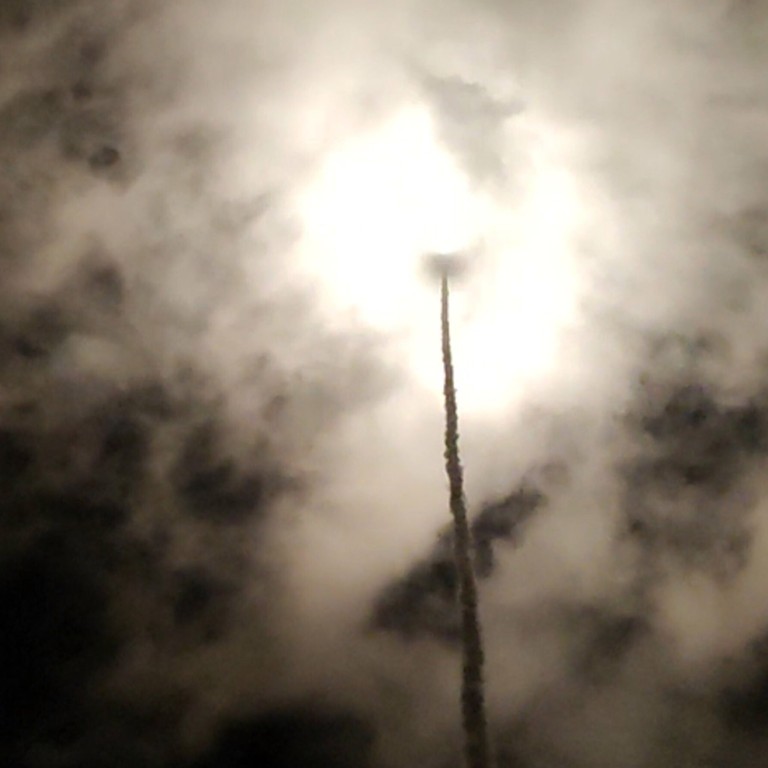
Beijing sends warplane to buzz Taiwan after missile test
- PLA aircraft crosses unofficial airspace boundary in Taiwan Strait after island launches missile-intercept drill
- Taipei scrambles fighter jets and situation ‘normal’, defence ministry says
The PLA Yun-8 transport plane crossed the median line in the strait on Friday, crossing the unofficial airspace boundary between the two parties.
Taiwan’s defence ministry said it responded by scrambling jet fighters.
“We detected the Chinese Communist Yun-8 aircraft flying southwest into Taiwan this morning and immediately dispatched our fighter jets to shadow it and disperse through radio warning,” the ministry said.
Describing the situation as “normal”, the ministry said it had full surveillance and control of all activities in the sea and air that surrounded Taiwan.
The incursion came after Taiwan’s National Chung-Shan Institute of Science and Technology test-fired two missiles off the eastern county of Taitung and the Jiupeng military base in the southernmost county of Pingtung on Thursday night.
Other missiles will be tested in coming days, according to the Taiwan Fisheries Agency which notified the public of the test dates and sites to warn off fishermen operating near the area.
Tensions over the Taiwan Strait are rising as mainland China, the United States and Taiwan have boosted military deployment.
The island’s defence ministry declined to say which type of missiles were tested on Thursday night. It would not confirm or deny that there would be more tests between Friday and Tuesday as the fisheries agency had publicised.
National Chung-Shan Institute of Science and Technology, which is developing the missiles, also declined to name the missiles, saying the test was in line with the defence ministry’s plan to develop the island’s own weapons.
Wang Ting-yu, a legislator from the ruling Democratic Progressive Party, who sits on the legislature’s defence and foreign relations committee, said the missile fired from Jiupeng was a Tien Kung-3 (Sky Bow-3) 200km-range surface-to-air missile designed to intercept guided missiles coming from mainland China. A Tien Kung-2 missile which served as the target was test-fired from Taitung, he said.
“The Tien Kung-3 successfully hit the target during the test, he said in his Facebook post on Friday.
How would China attack Taiwan? A video outlines one scenario
The test came just two months after the island test-fired a Tien Kung-3 and a medium-range Yun Feng (Cloud Peak) land-attack cruise missile between April 5 and April 23 at the Jiupeng base.
While the Tien Kung can intercept incoming missiles, the Yun Feng, which has a range of 1,500km, can strike targets in inner China, including Beijing, Tianjin in China’s north, Nanjing in eastern Jiangsu province, Shanghai in the east and Wuhan, Changsha and the Three Gorges Dam in central China.
Reports of Yun Feng development first surfaced in December 2012, but the programme has been under way since the post-1996 Taiwan Strait crisis, when Beijing staged missile tests near Taiwan to try to warn then president Lee Teng-hui against promoting independence.
The Tien Kung-3 is a third-generation area defence system, developed by the institute to intercept a tactical ballistic missile.
According to the institute, the Tien Kung-3 weapon system is constructed by missile, canister and fire control units.
“The weapon system could engage high performance fighters, cruise missiles, anti-radiation missiles and short-range ballistic missiles with multiple simultaneous engagements. It is designed to be operated by battery autonomously or under control from higher echelon units,” the institute said on its website.
Military commentator Song Zhongping said Thursday night’s Tien Kung-3 interception test would probably not be seen by the PLA as a significant threat, because the target was a Tien Kung-2, which had a top speed of just Mach 4.3, while a ballistic missile in its terminal stage moved at more than Mach 10.
“It did not prove that the Tien Kung-3 is capable of intercepting a ballistic missile,” he said. “So it won’t affect the military power balance much.”
Li Da-jung, a professor of strategic studies at Tamkang University in Taipei, said that given Taiwan’s limited budget and that it was impossible to stage an arms race with the mainland, developing its own missiles fit with the island’s asymmetric warfare in countering Beijing.
“Taiwan’s military has over the years emphasised the development of asymmetric warfare in countering mainland China, and missiles are one of the important devices employed by asymmetric warfare,” he said.
Li said the institute had been given the task of developing the island’s own missiles for decades and had had notable achievements that had drawn concern from Beijing, the US and other countries in the region.
“The test of the missiles on Thursday night was just a part of its long-term development programme, which should not be viewed as sabre-rattling in response to recent intrusion of a group of warplanes from the mainland,” he said.
A group of Sukhoi Su-30 fighter jets flew into the Taiwan Strait and briefly approached Taiwan, just hours after a US transport plane passed over the island on Tuesday.
Taiwan scrambled its warplanes to warn off the PLA fighter jets which crossed the median line in the Taiwan Strait on Tuesday morning, according to the island’s defence ministry.
The incursion came just several hours after a US C-40A transport plane made a rare flight into Taiwan over the southwest coast early that morning, flying from the US airbase in Okinawa and passing over Taiwan’s Keelung, New Taipei, Taipei, Taoyuan, Hsinchu, Miaoli, Taichung, Changhua, Chiayi, Tainan and into the Taiwan Strait towards the Bashi Channel, according to AirNav, which provides air traffic control information.
The flyover prompted angry protests from Beijing on Thursday. Zhu Fenglian, a spokeswoman for the mainland’s Taiwan Affairs Office called the act a violation of the international law and US-China relations. She also condemned Taiwan for colluding with “external force to violate the sovereignty and national security of China, and sabotage the peace and stability in the Taiwan Strait”.
Additional reporting by Liu Zhen

